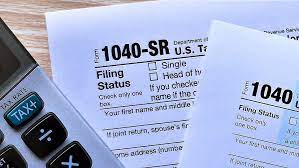
Understanding the Difference Between Filing a 1040 and 1040-SR in 2024 & 2025

IRS Form 1040-SR for Seniors
Tax season can be a confusing time for many Americans, especially when it comes to understanding the differences between filing a 1040 and 1040-SR.
TRAVERSE CITY, MI, UNITED STATES, October 11, 2024 /EINPresswire.com/ -- Tax season can be a confusing time for many Americans, especially when it comes to understanding the differences between filing a 1040 and 1040-SR.
As the tax deadline approaches, it's important for taxpayers to be aware of the distinctions between these two forms and how they may impact their tax filing process.
The 1040 form is the standard individual income tax return form that is used by taxpayers to report their annual income to the IRS. It is the form that most people are familiar with and is used by individuals of all ages. On the other hand, the 1040-SR form is specifically designed for individuals who are 65 or older. It offers a larger text size and a more straightforward layout, making it easier for older taxpayers to read and comprehend.
One key difference between the two forms is the eligibility criteria. While anyone can use the 1040 form, the 1040-SR is exclusively for seniors. It is important for taxpayers to be aware of their eligibility for the 1040-SR, as using the wrong form can result in delays or complications in the tax filing process.
Another notable difference is the standard deduction chart. The 1040-SR form has a specific section that provides the standard deduction chart for seniors, which is not included in the regular 1040 form.
This chart outlines the standard deduction amounts for individuals who are 65 or older, taking into account their filing status and whether they are blind. Understanding the standard deduction chart is crucial for seniors to ensure that they are claiming the correct deduction amount on their tax return.
Furthermore, the 1040-SR form includes a specific checkbox for the "Credit for the Elderly or the Disabled," which is not present on the regular 1040 form. This credit is available to individuals who are either 65 or older or retired on permanent and total disability. By utilizing the 1040-SR form, eligible taxpayers can easily claim this valuable credit without any confusion or oversight.
In conclusion, as taxpayers prepare to file their annual tax returns, it is essential to understand the differences between the 1040 and 1040-SR forms. By being aware of the eligibility criteria, standard deduction chart, and specific tax credits available, individuals can ensure a smooth and accurate tax filing process.
Taxpayers who are 65 or older should consider using the 1040-SR form to take advantage of the tailored features designed to simplify the tax filing experience for seniors.
To learn more about the Difference Between Filing a 1040 and 1040-SR, visit https://nationaltaxreports.com/what-is-the-difference-between-filing-a-1040-and-1040sr/
Frank Ellis
Harbor Financial
email us here
Visit us on social media:
LinkedIn
Distribution channels: Banking, Finance & Investment Industry, Business & Economy, Culture, Society & Lifestyle, Social Media, U.S. Politics
Legal Disclaimer:
EIN Presswire provides this news content "as is" without warranty of any kind. We do not accept any responsibility or liability for the accuracy, content, images, videos, licenses, completeness, legality, or reliability of the information contained in this article. If you have any complaints or copyright issues related to this article, kindly contact the author above.
Submit your press release